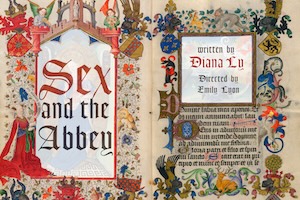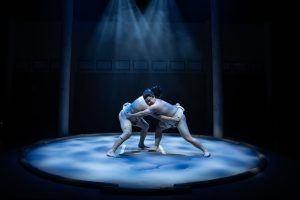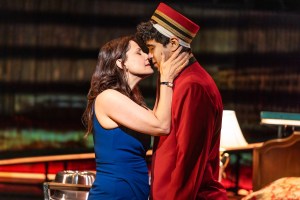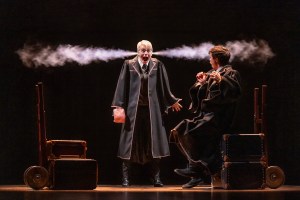Review: Sex and the Abbey Illuminates the Medieval Solution for Childless Cat Ladies
Diana Ly’s one-act drama makes its world premiere at the Brick.

(© Cindy Trinh)
Vice Presidential candidate JD Vance’s comment that America is plagued by “childless cat ladies” rankles, I suspect for the same reason Leftwing hyperventilation about “incels” frustrates the Right: It observes a real phenomenon and wildly overstates the extent to which it is a problem.
A country that hugely overproduces elites doesn’t need them to further reproduce. Rather, it needs spaces where the children of the elite, both men and women, can escape the expectation of reproduction while still actively contributing to society.
For nearly 1,000 years, Gandersheim Abbey served as a refuge for the clever and often childless daughters of the most powerful families of Saxony — most notably the 10th-century canoness Hrotsvitha, whose dramas are a crucial bridge between the ancient and modern worlds. Diana Ly’s world premiere play at the Brick, Sex and the Abbey, is set at Gandersheim and offers a compelling explanation for why a rich young woman living in medieval Germany might want to forswear earthly marriage and become a bride of Christ. As is true today, marriage to a dead savior was often preferable to the available selection of living single men.
Sex and the Abbey takes place over the course of one momentous day during which Gandersheim hosts the Holy Roman Emperor, Otto the Great. A nearby monastery has claimed dominion over Gandersheim and the emperor has arrived to settle the dispute — essentially deciding whether the abbey will fall under the control of men or maintain its independence as a space run by women. Hrotsvit (Jen Anaya) hopes to win his favor with a performance of her play, Callimachus, starring her sisters in Christ Mathilda (Tia Cassmira), Adelheid (Francesca Fernandez), and Hadwig (Belle Le). As they rehearse, we get to know about each of them and why they decided to come to Gansersheim.
“To meet women,” Adelheid bluntly confesses to Hrotsvit. And indeed, if you were a 10th-century lesbian, your best option was to enter a religious order: Cloistered from the male gaze, one could perform cunnilingus to one’s heart’s content, shielded by the widely held assumption that sex is impossible without a phallus present. Wide-eyed and eager to please, Fernandez plays Adelheid with the perfect mixture of affability and insistence. She’s a straight-A student with a secret wild side.
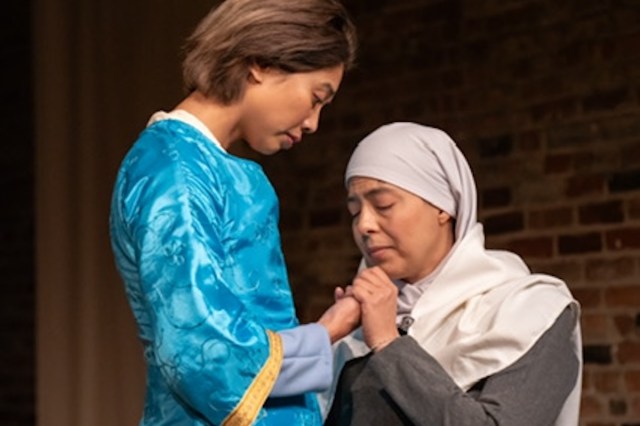
(© Cindy Trinh)
Not so for Hadwig, who wears her transgression on her sleeve. She questions why Drusiana, the pious young Christian woman in Hrotsvit’s play, must die while her killer converts and receives salvation. She would like a more solidly feminist resolution. Le’s performance as Hadwig is jarringly contemporary, giving voice to our 21st-century values while fully inhabiting this 10th-century world. It’s a balance that many playwrights attempt, but few achieve as successfully as Ly has here.
Some of that can be credited to the steady hand of director Emily Lyon, who establishes the time and place from the moment we enter: The truncated arches and single iron candelabra of Kim Zhou’s set place us instantly in a convent, while pre-show polyphony leaves no doubt (sound design by Chiara Pizzirusso). Nor do Saawan Tiwari’s costumes, which smartly eschew the austere black of more modern religious orders, allowing for a wider range of expression for the individual characters. Lighting designer Yang Yu bathes the stage in an ethereal blue glow, while Cinthia Chen’s projections of illuminated manuscripts illustrate the liturgical hours that delineate each scene.
Sex and the Abbey is a smart play, and certainly more fun to watch than the dreadful Mary Gets Hers, which covered similar ground. Still, at just one hour it feels a bit slim, brimming with untapped potential (Mathilda is a particularly underwritten character). Certainly, this tale of medieval scissor sisters is not nearly as funny as it could be, even as Ly rubs up against the delicious contrast of sacred and profane that is the fiery heart of the story.
Ly is clear-eyed about the limitations of places like Gandersheim, which did not require its inhabitants to take vows and was often used as a repository for rich young virgins until the point of marriage. This becomes especially apparent when two noble brothers, present for the performance of Callimachus, select their brides from the cast, like Ottonian Broadway investors. Power is power, even under God’s eye.
Rather than impugn childless cat ladies, Vance should quietly celebrate his political adversaries’ decision to not reproduce, while loudly cheering the abundance of choice a pluralistic United States offers to its citizens. Sex and the Abbey is an important reminder of a time with fewer options, but also the human ability to adapt within such limitations.


